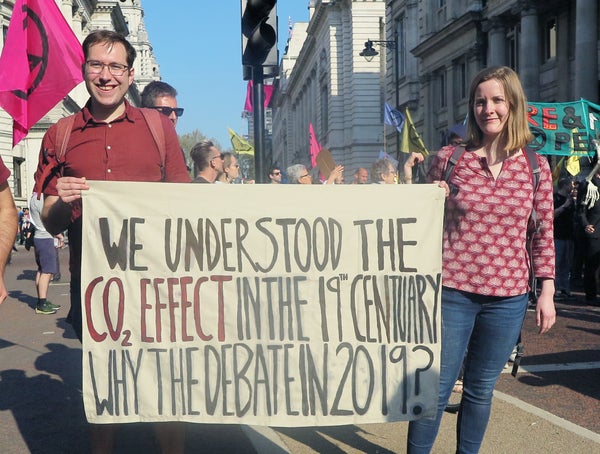This article was published in Scientific American’s former blog network and reflects the views of the author, not necessarily those of Scientific American
John Tyndall was a mountaineer, prolific writer of science books, prominent physicist and professor of natural philosophy at the Royal Institution of Great Britain. He was also an original member of the X Club, an exclusive scientific dining club whose members were frequent contributors to the well-regarded journal Nature.
With his doctorate, easy access to the Royal Institution’s laboratories, and social and intellectual friendships and networks with some of the greatest minds of the Victorian period, it is not surprising that Tyndall reached the heights of scientific achievement and recognition.
For more than 160 years Irish-born Tyndall has been credited with the original discovery of the absorption of thermal radiation by carbon dioxide and water vapor—the very cornerstone of our current understanding of climate change, weather and meteorology. He was the first to clearly demonstrate and understand the physical basis of the greenhouse effect.
On supporting science journalism
If you're enjoying this article, consider supporting our award-winning journalism by subscribing. By purchasing a subscription you are helping to ensure the future of impactful stories about the discoveries and ideas shaping our world today.
Another first originated with a hidden figure in the history of climate science, one who remained unacknowledged until brought to light in 2011 by independent researcher Raymond Sorenson. Later researched by writer John Perlin and the main subject of a symposium held in May 2018 at the University of California, Santa Barbara, this previously unknown contributor to our current understanding of climate change was an American amateur scientist, a suffragette and a woman: Eunice Newton Foote, born 200 years ago.
Three years before Tyndall first published his broad findings in the Proceedings of the Royal Society of London in 1859, Foote demonstrated the absorption of solar heat by carbon dioxide and water vapor and wrote up her findings in a paper entitled “Circumstances Affecting the Heat of the Sun’s Rays.” While Foote did not differentiate between heat from the whole solar spectrum and long-wave infrared, which is actually responsible for the greenhouse effect, she does seem to be the first to suggest that changing amounts of carbon dioxide and water vapor could alter the climate. Tyndall understood the difference, though he did not use the term “long-wave infrared” because it was not yet invented.
Certainly, Tyndall’s equipment, laboratory and experimental results were more sophisticated than Foote’s, and he is rightly credited with establishing the experimental basis for the greenhouse effect, first suggested by Swiss physicist Horace Bénédict de Saussure in the the 1760sand later developed by French mathematician Joseph Fourier in the 1820s and French physicist Claude Pouillet in 1836 And yet, while acknowledging these men’s work, Tyndall did not reference Foote’s. Why?
There is some debate about whether Tyndall even knew of Foote’s work, though there was some mention of her paper in various North American publications. For example, the September 13, 1856, issue of Scientific American, reported that her experiment on the effects of the sun’s rays on different gases afforded “abundant evidence of the ability of woman to investigate any subject with originality and precision.”
According to Roland Jackson, Tyndall’s biographer, general editor of his correspondence and past chief executive of the British Science Association, it seems safe to assume that “if anyone had seen it and understood its significance, there would be some evidence of this, as they would have informed Tyndall and/or each other.” But to date, not a single reference to her work has been found in any letter, journal or publication of the major contemporary figures in this field. Therefore, it seems most likely that very little, if any, significant discussion or proper citations or summaries of her study reached England during the time Tyndall was working on and publishing his research.
Did Tyndall know about Foote’s work and simply ignore it because she was an amateur, an American or a woman? Perhaps. During Victorian England, a prejudice against amateurs, Americans and women as not quite as capable or professional as British men existed. And Tyndall was no democrat and no supporter of female emancipation.
Did he know about the significance of Foote’s study and actively plagiarized it? Maybe, although, as Jackson points out, this would be entirely out of character and extremely risky. Furthermore, both Jackson and Ed Hawkins, a climate scientist at the National Center for Atmospheric Science and the University of Reading in England, feel that if Tyndall had actually known about Foote’s results, he would have started his experiments using CO2 and water vapor. He didn’t: Tyndall initially tried dry air, oxygen, hydrogen and nitrogen before experimenting on CO2 and water vapor.
Is the lack of credit for Foote linked to insufficient information, prejudice or a deliberate omission on Tyndall’s part? Whatever the truth is, and we may never know, it is now clear that Foote’s experiment added to the understanding of climate science. As Katharine Hayhoe, co-director of the Climate Science Center at Texas Tech University, has pointed out, while Foote’s research did not directly establish the physical basis of what we now call the greenhouse effect, she appears to have been the first person to notice the ability of carbon dioxide and water vapor to absorb heat and to make a direct link between the variability of these atmospheric constituents and climate change.
For this achievement, Foote clearly deserves a place on the pantheon of past and present climate scientists and those to come in the future.
